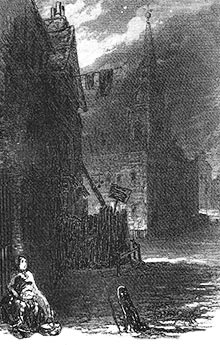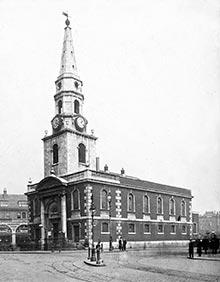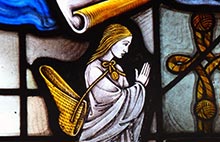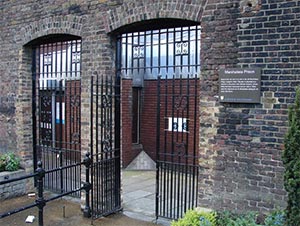Charles Dickens'
Little Dorrit
Little Dorrit - The Marshalsea Revisited
Little Dorrit - Published in monthly parts Dec 1855 - June 1857
In his eleventh novel, illustrated by Phiz and published by Bradbury and Evans, Charles Dickens' childhood memories of his father's imprisonment in the Marshalsea for debt are brought forth again as the centerpiece of the story of William Dorrit, whose family is also imprisoned there.
Dickens sets the novel in the 1820's, around the time his father was an inmate in the Marshalsea (Little Dorrit, p. 1), but virtually ignores that time period during the novel to address issues that relate to the 1850s (Davis, 1999, p. 215). The theme of imprisonment, both physical and psychological, carries throughout the novel.
Dickens notes in the preface for the completed novel that he had never had so many readers, indeed, sales of the monthly installments topped both Bleak House and David Copperfield (Slater, 2009, p. 407). Critic's responses to the novel were mixed with some saying that Dickens should stick with comedy rather than political satire (Kaplan, 1988, p. 340). George Bernard Shaw called the book "more seditious than Das Kapital" (Laurence and Quinn, 1985, p51,64 as cited in Schlicke, 1999, p. 341).
This book, along with its predecessor, Hard Times, marked a turn in Dickens' writing toward a darker and gloomier outlook on life.
Complete List of Characters:
Character descriptions contain spoilersLittle Dorrit Links:
The Victorian WebBartleby.com
Bibliomania
Wikipedia
The Marshalsea Prison
In the preface to Little Dorrit Charles Dickens describes a visit to Southwark to see what, if anything, remained of the Marshalsea Prison, which closed in 1842.
It is curious that in the thirty years since his father was imprisoned there Dickens seems not to have visited the site just across the Thames. He found that 'the front courtyard, often mentioned [in the story], metamorphosed into a butter-shop' and the former walls and blocks of the prison assimilated into the neighborhood.
Charles Dickens' readers were not aware of his intimate relationship to the prison, the story of his father's imprisonment there not being told until his first biographer, John Forster, revealed it after Dickens' death in 1870 (Forster, 1899, v. 1, p. 22-39).
At the beginning of Book the First, Chapter 6 of Little Dorrit Dickens introduces the reader to the prison:
Thirty years ago there stood, a few doors short of the church of Saint George, in the borough of Southwark, on the left-hand side of the way going southward, the Marshalsea Prison. It had stood there many years before, and it remained there some years afterwards; but it is gone now, and the world is none the worse without it. It was an oblong pile of barrack building, partitioned into squalid houses standing back to back, so that there were no back rooms; environed by a narrow paved yard, hemmed in by high walls duly spiked at top. Itself a close and confined prison for debtors, it contained within it a much closer and more confined jail for smugglers. Offenders against the revenue laws, and defaulters to excise or customs who had incurred fines which they were unable to pay, were supposed to be incarcerated behind an iron-plated door closing up a second prison, consisting of a strong cell or two, and a blind alley some yard and a half wide, which formed the mysterious termination of the very limited skittle-ground in which the Marshalsea debtors bowled down their troubles (Little Dorrit, p. 57).
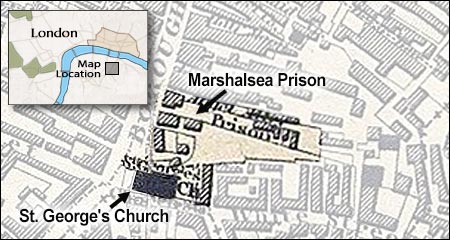
The medieval Marshalsea Prison dated from the 14th century. In 1811 the decaying prison was torn down and a new Marshalsea was built a few blocks further down Borough High Street. This was the prison in which Dickens' father was incarcerated in 1824 and to which Dickens sent William Dorrit in Little Dorrit (White, 2016, p. 177-178).
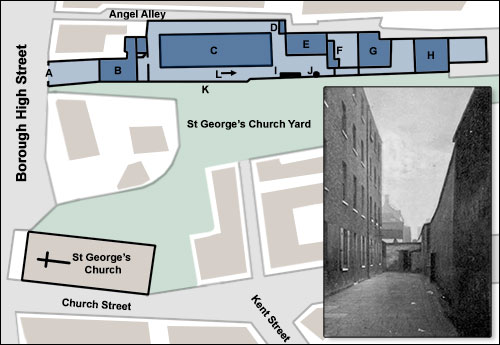
A - Gate
B - Keeper's House and lodge
C - Block of eight back-to-back four-storey houses containing 56 rooms for debtors. The average room was 10 feet 10 inches square containing one window.
D - Privies
E - Suttling House which included a day room and an ale room and bar
F - Wash House
G - Admiralty Prison used by the navy to house sailors convicted of crimes at sea. When empty it was used as overflow for debtors.
H - Chapel
I - Cistern
J - Pump
K - Remaining wall of the Marshalsea.
L - A photo taken from this vantage point is shown in the inset. The photo was taken in 1897 after the prison had closed and the former prisoner barracks on the left were used to house poor families. The wall on the right, having been shortened after this photo was taken, can still be seen today.
Circumlocution Office
Charles Dickens' satiric representation of the Civil Service, where the Barnacle family demonstrates how to go around in circles, spewing red tape, and accomplishing nothing, draws on recent government bumbling during the Crimean War (Little Dorrit, p. xvii)...and perhaps just a hint of leftover cynicism from Dickens' days as a young parliamentary reporter.
- Sketches by Boz |
- Pickwick |
- Oliver Twist |
- Nickleby |
- Old Curiosity Shop |
- Barnaby Rudge |
- Chuzzlewit |
- Christmas Carol |
- Christmas Books |
- American Notes |
- Pictures from Italy |
- Dombey and Son |
- Copperfield |
- Bleak House |
- Hard Times |
- Little Dorrit |
- Tale of Two Cities |
- Great Expectations |
- Our Mutual Friend |
- Edwin Drood |
- Minor Works |
- The Uncommercial Traveller |
- Short Stories

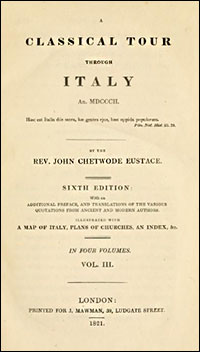
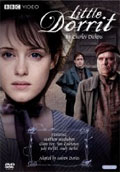
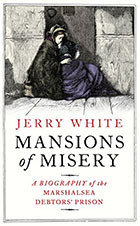

 In 1830, when Charles Dickens was 18 years old he fell madly in love with the daughter of a successful banker, Maria Beadnell. He courted Miss Beadnell for three years, although her parents objected to the relationship and the courtship ended with Dickens heartbroken
In 1830, when Charles Dickens was 18 years old he fell madly in love with the daughter of a successful banker, Maria Beadnell. He courted Miss Beadnell for three years, although her parents objected to the relationship and the courtship ended with Dickens heartbroken 
